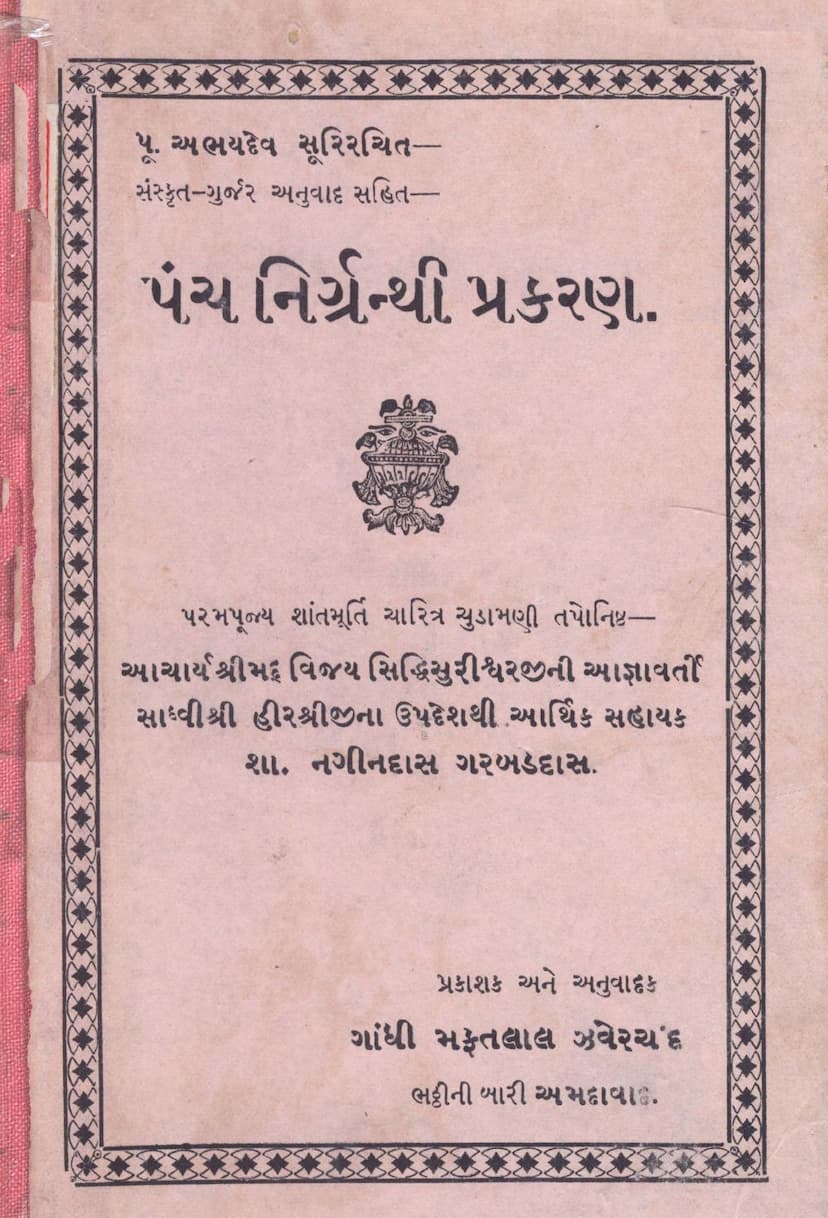Panch Nirgranthi Prakaran
Added to library: September 2, 2025

Summary
This is a comprehensive summary of the Jain text "Panch Nirgranthi Prakaran" by Acharya Shrimad Abhaydevsuri, with Gujarati translation and commentary by Mafatlal Zaverchand Gandhi. The text itself is a compilation of 106 verses (gathas) that summarize the 6th Uddeshaka of the 25th Shataka of the Bhagavati Sutra.
Book Overview:
- Title: Panch Nirgranthi Prakaran (Five Types of Nirgranthas)
- Author: Acharya Shrimad Abhaydevsuri (Original Sanskrit work)
- Translator/Commentator: Mafatlal Zaverchand Gandhi (Gujarati translation and commentary)
- Publisher: Mafatlal Zaverchand Gandhi
- Key Themes: The text systematically explores the nature and classifications of the five types of Nirgranthas (ascetics who have renounced worldly attachments) within the framework of Jain philosophy, using various "Dwaras" (gateways or topics of inquiry).
- Purpose: To provide a clear and accessible explanation of Abhaydevsuri's verses on the subject of Nirgranthas, making the complex teachings understandable.
Core Content and Structure:
The book is structured around the analysis of five types of Nirgranthas:
- Pulaka: The lowest category, characterized by some minor transgressions or lapses in their vows, though their overall conduct is commendable.
- Bakush: A step higher than Pulaka, they may exhibit more significant indulgences in the use of equipment or personal adornment, still within limits but showing a greater tendency towards attachment.
- Kushil (also referred to as Pratisevana Kushil and Kashaya Kushil): These ascetics have fallen prey to passions (kashaya) or transgressions (pratisevana) that defile their character.
- Nirgranth: True ascetics who are free from attachment and aversion, possess equanimity towards all beings, and strive for the highest spiritual attainment.
- Snathak: The highest category, having attained omniscience (Kevalgyan) and liberated from all karmic bondage, having completed their spiritual journey.
The text then delves into these five types through 36 Dwara (topics of inquiry), systematically examining various aspects of their spiritual life, conduct, and karmic disposition. These Dwara include:
- Prajnapanadwara (Knowledge/Explanation Gateway): Defining the five types of Nirgranthas and their subdivisions.
- Vedadwara (Desire Gateway): Analyzing the types of desires (Purush ved, Stri ved, Napunsak ved) present in each type of Nirgranth.
- Ragadwara (Attachment Gateway): Discussing the presence or absence of attachment in each category.
- Kalpadwara (Rules/Conduct Gateway): Exploring the adherence to Jain ascetic rules (Kalpa) and their variations.
- Samyamadwara (Self-Control Gateway): Examining the different levels of self-control and character (Charitra) observed.
- Pratisevanadwara (Transgression Gateway): Detailing the types and extent of transgressions committed by each type.
- Jnanaadwara (Knowledge Gateway): Analyzing the types and extent of spiritual knowledge possessed by each.
- Tirthadwara (Spiritual Community Gateway): Discussing their presence within the established four-fold Jain community (Sangh) or outside it.
- Lingadwara (External Marks Gateway): Examining the external symbols and appearances that might differentiate them.
- Shariradwara (Body Gateway): Discussing the types of bodies (audarik, vaikriya, aaharak, tejas, karmic) associated with each.
- Kshetadwara (Region Gateway): Identifying the geographical regions (Karmabhumi, Akarmabhumi) where they are found or originate.
- Kaladwara (Time Gateway): Analyzing their existence and activities in different time cycles (Utsarpini and Avasarpini).
- Gatidwara (State/Destination Gateway): Discussing their past, present, and future rebirths and ultimate destinations.
- Sanyamadwara (Self-Control Gateway): Further elaborating on the practice and levels of self-control.
- Nikarsadwara (Comparison Gateway): Comparing the relative merits and demerits of each type.
- Yogadwara (Activity Gateway): Analyzing the types of activities (mind, speech, body) they engage in.
- Upagadwara (Cognition Gateway): Examining their cognitive faculties and awareness.
- Kashayadwara (Passions Gateway): Detailing the intensity and types of passions (kashaya) present.
- Leshyaadwara (Aura Gateway): Describing the color and nature of their karmic aura.
- Parinamadwara (Disposition Gateway): Analyzing their mental and emotional states.
- Bandhadwara (Bondage Gateway): Discussing the types and extent of karmic bondage they are subject to.
- Vedadwara (Experience Gateway): Examining the types of experiences they undergo.
- Karmodyranadwara (Karmic Eruption Gateway): Analyzing the shedding or premature activation of karma.
- Upsamapadanadwara (Sublimation Gateway): Discussing the process of overcoming passions and karma.
- Sannnadwara (Instinct/Tendency Gateway): Examining their ingrained tendencies and instincts.
- Aaharadwara (Nourishment Gateway): Discussing their sustenance and dietary practices.
- Bhavadwara (Existence Gateway): Exploring their life cycles and rebirths.
- Akarsadwara (Attraction Gateway): Analyzing their spiritual progress and regressions.
- Kaladwara (Time Gateway): Further detailing time-related aspects.
- Antaradwara (Interval Gateway): Discussing the intervals between spiritual attainments.
- Samudghatadwara (Emanation Gateway): Analyzing the supernatural powers or emanations they might possess.
- Avagahanadwara (Spatial Extent Gateway): Describing the spatial presence of their soul-substance.
- Sparshanadwara (Contact Gateway): Examining their interactions and karmic contacts.
- Bhavadwara (Disposition Gateway): Further exploration of their spiritual states.
- Parimanadwara (Quantification Gateway): Discussing the numbers and quantities associated with each type.
- Alpa-bahutvaadwara (Quantity Comparison Gateway): Comparing the relative numbers of each type.
Key Concepts Explained:
The book provides detailed explanations for various Jain philosophical concepts within the context of the Nirgranthas, including:
- The Five Nirgranthas: Pulaka, Bakush, Kushil, Nirgranth, and Snathak.
- The Five Types of Knowledge: Mati, Shruta, Avadhi, Manahparyay, and Kevala Gyan.
- The Five Types of Bodies: Audarik, Vaikriya, Aaharak, Tejas, and Kaarmic.
- The Five Types of Passions (Kashaya): Anantanubandhi, Apratyakhyani, Pratyakhyani, and Sanjvalan (with focus on the latter due to its relevance in lower spiritual states).
- The Three Types of Desires (Ved): Purush Ved, Stri Ved, Napunsak Ved.
- The Three Types of Time: Kalpadwara (rules), Kaladwara (time), and Ati-kaal (beyond time).
- The Five States of Existence (Bhav): Oopshamik, Kshāyik, Kshāyopshamik, Aaudayik, and Parinamik.
- The Seven Types of Samudghat: Vedana, Kashaya, Maran, Vaigriya, Tejas, Aaharak, and Kevali.
Significance:
"Panch Nirgranthi Prakaran" is a vital text for understanding the nuances of ascetic conduct and spiritual progression in Jainism. It provides a structured and detailed classification of ascetics, helping practitioners to understand the different stages of spiritual discipline, the challenges faced at each stage, and the ultimate goal of liberation. The Gujarati translation and commentary by Mafatlal Zaverchand Gandhi make this profound text accessible to a wider audience.